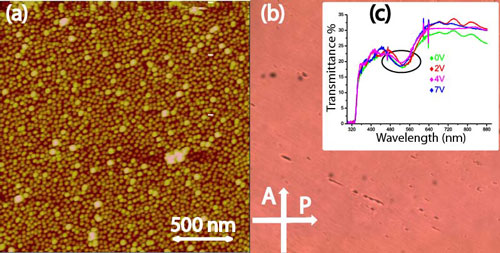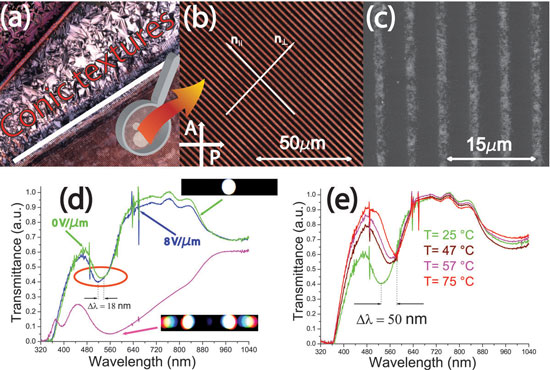| Posted: Oct 22, 2012 | |
Towards smart plasmonics |
|
| (Nanowerk Spotlight) By exploiting the outstanding properties of self-organizing materials – so-called smart matter – a team of Italian scientists has investigated a new way to build a bridge between two branches of physics: 'hard matter' and 'soft matter'. This allows researchers at the University of Calabria (UNICAL) to address specific issues towards the realization of active-plasmonics devices, where the plasmonic resonance of gold nanoparticles (GNPs) can be finely controlled by means of external perturbations (electrical field, optical field, temperature). | |
| According to UNICAL scientist Luciano De Sio, in place of a static approach – e.g. varying particles size, materials, etc. – liquid crystals can be used as active surrounding medium. This approach represents a 'scientific wedding' between the fascinating soft matter and the intriguing plasmonics worlds, adds UNICAL scientist Roberto Caputo. | |
| This research activity originated within the framework of the European Nanogold project (coordinated by Toralf Scharf at EPFL). In a first attempt, the Italian team in collaboration with Thomas Bürgi's group at the University of Geneve, achieved a two-fold active control of the plasmonic resonance of randomly distributed gold nanoparticles by combining bottom-up and self-assembly processes. The researchers immobilized gold nanoparticles on an indium tin oxide (ITO) coated glass substrate and then covered them with a liquid crystalline compound. | |
 |
|
| Fig. 1: AFM topography of the gold nanoparticle distribution (a) and Polarized Optical Microscope view of the sample (b) along with its spectral response (c) for different values of the applied voltage. (Reprinted with permission from Royal Society of Chemistry) | |
| The Atomic Force Microscopy (AFM) topography shown in Fig. 1a confirms the presence of isolated gold nanoparticles with an average radius of about 15 nm, while the Polarized Optical Microscope (POM) micrograph depicted in Fig. 1b shows a uniform alignment of the Nematic Liquid Crystals (NLC) overlaying the gold nanoparticle substrate. | |
| The researchers investigated the NLC birefringence variation effect on the plasmonic resonance of the GNPs array by analyzing the spectral response of the sample for different values of an applied electric field; obtained results are reported in Fig. 1c. | |
| According to the optics group coordinator Cesare Umeton, it is worth noting that, by increasing the value of the applied field, the plasmonic absorption peak exhibits a 'dancing behavior', with a continuous blue-red shift of its position. This behavior can be explained by taking into account the presence of two active media: the NLC and the ITO film underlying the GNP distribution. | |
| As the researchers reported in the September 26, 2012 online edition of Nanoscale ("Double active control of the plasmonic resonance of a gold nanoparticle array"), they both behave as 'active' media surrounding the GNP array. | |
| In a further experiment, the team used a combination of top-down and bottom-up approaches to induce the self-organization of Cholesteric Liquid Crystals (CLC) infiltrated in a micro-periodic polymeric template, and thus the nanoscale organization of GNPs that are surrounding the CLC. | |
 |
|
| Fig. 2: POM view of the polymeric template infiltrated with CLC and GNPs mixture at the edge of the grating area (a). High magnification of the channels infiltrated with GNPs doped CLCs aligned in ULH geometry (b) and EBSD of the same area (c). Spectral response of the sample for two values of the external electric field (d) and versus its temperature (e). (Reprinted with permission from Royal Society of Chemistry) | |
| In particular, Fig. 2a shows a POM micrograph of the sample at the edge of the photo-sculptured periodic template; on the left, the photo puts into evidence the existence of a standard focal conic texture, induced by a random distribution of the CLC helical axes. On the right, the periodic polymeric structure induces a Uniform Lying Helix (ULH) configuration (high magnification, Fig. 2b). The presence of GNPs inside the microstructure is confirmed by the Electron Back-Scattering Diffraction (EBSD) characterization of the sample reported in Fig. 2c. | |
| From an optical characterization of the sample, it is evident that p-polarized light is strongly diffracted, and its transmission is almost suppressed (diffraction pattern of Fig. 2d, magenta curve). In contrast, s-polarized light is highly transmitted in almost the whole analyzed spectral range (diffraction pattern of Fig. 2d, green curve). By applying an external electric field across the sample, the CLC average refractive index value is lowered, with a consequent blue shift of the plasmonic resonance of about 20 nm (blue curve, Fig. 2d). | |
| An additional demonstration of the tunability of the plasmonic response of this novel composite structure has been obtained by varying the temperature of the sample. By means of a miniature oven, it was possible to vary the sample temperature from 25°C up to 75°C; a red-shift of the plasmonic absorption peak was observed in the range from 532 nm to 582 nm. As reported previously (see paper in Journal of Materials Chemistry: "Broad band tuning of the plasmonic resonance of gold nanoparticles hosted in self-organized soft materials"), this effect can be explained in terms of a temperature induced passage from densely packed to mono-dispersed GNPs. | |
| By Luciano De Sio, University of Calabria | |
|
Become a Spotlight guest author! Join our large and growing group of guest contributors. Have you just published a scientific paper or have other exciting developments to share with the nanotechnology community? Here is how to publish on nanowerk.com. |
|
